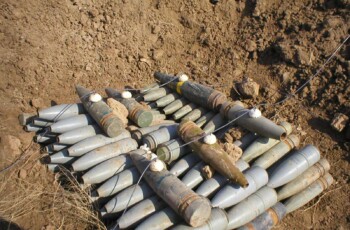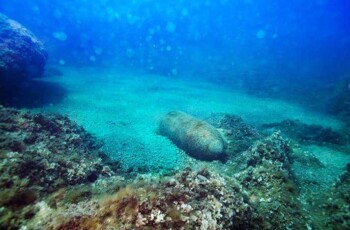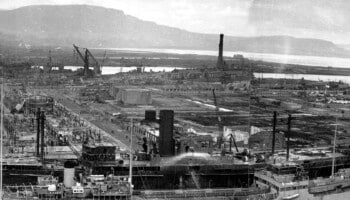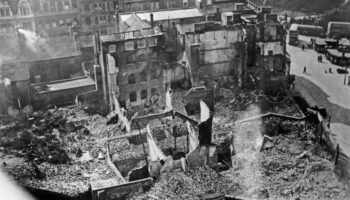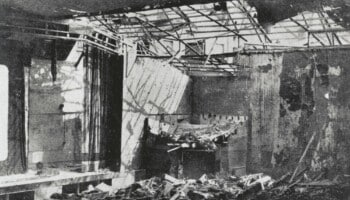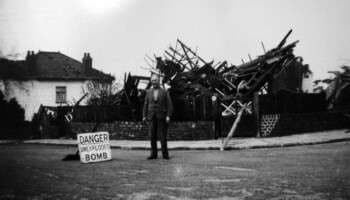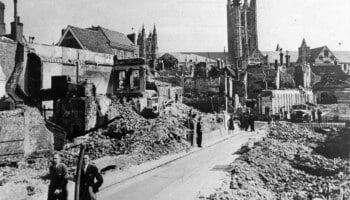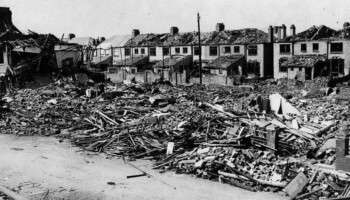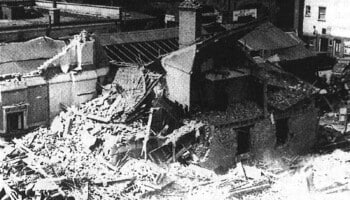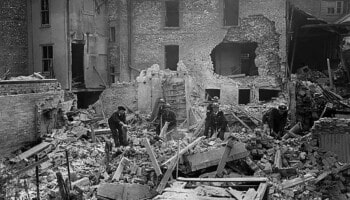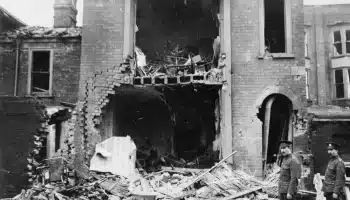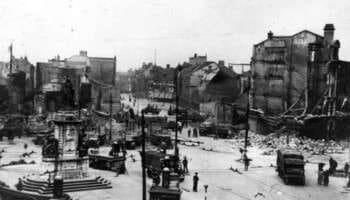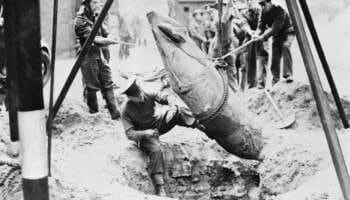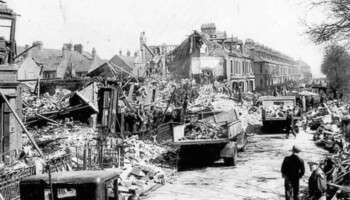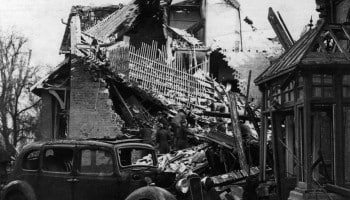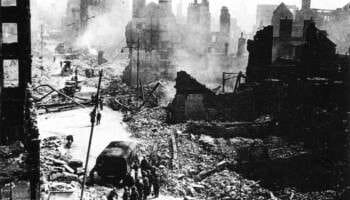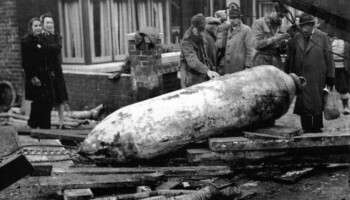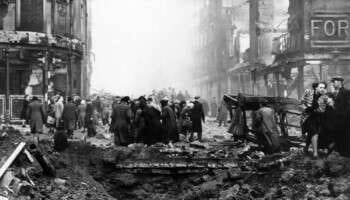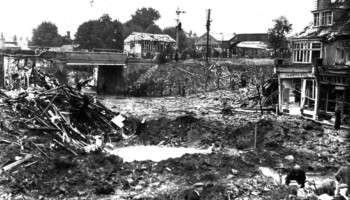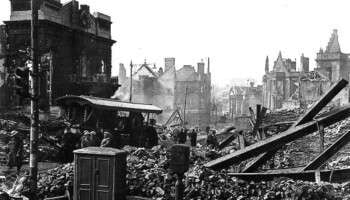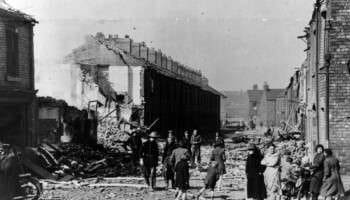Home » Resources » UXO City Guides »
UXO City Guide
Home Office Bombing Statistics for Liverpool
Record of German Ordnance dropped on the County Borough of Liverpool
High Explosive Bombs (All types)
2,332
Parachute Mines
117
Oil Bombs
50
Phosphorus Bombs
0
Fire Pots
0
Pilotless Aircraft (V-1)
0
Long-range Rocket Bombs (V-2)
0
Weapons Total
2,499
Area Acreage
27,321
Number of items per 1,000 acres
91.5
Why was Liverpool targeted and bombed in WWII?
The outbreak of WWII placed Liverpool in a positon of immense strategic importance. After London, it was the United Kingdom’s largest port, as well as being the major port closest to the United States of America.
In 1939, in addition to being a busy centre for coastal traffic, it handled almost one-third of the nation’s imports and exports1. Vital wartime food supplies and military equipment from America and Canada were shipped to Liverpool, which made the docks vulnerable to attack from the Luftwaffe.
Merseyside’s eleven miles of docks and wharves handled more than 90% of all war-related supplies entering Britain from abroad. In addition, Liverpool was also home to the Western Approaches Command – a strategic base for the Navy to plan the Battle of the Atlantic.
As such, given Liverpool was the UK’s main transatlantic convoy port during WWII, a number of key areas bordering the River Mersey were strategic bombing targets for the Luftwaffe.
Home Office Bombing Statistics for Liverpool
A total of 2,499 recorded bombs fell on the County Borough of Liverpool, equating to 91.5 items of ordnance per 1,000 acres.
During the Liverpool Blitz, one of the buildings which was destroyed was the office of the Area Technical Intelligence Officer, which contained a number of early bomb maps and tracings of incidents.
As such, the records for Liverpool tend to be mixed and inaccurate. Dock areas and the city centre is typically well documented, yet records for the suburbs are limited.
Major bombing raids in Liverpool
Following a Royal Air Force (RAF) raid on Berlin on the 25th August 1940, Hitler personally influenced a change in Luftwaffe bombing tactics. The Luftwaffe moved away from bombing RAF Stations, Military Camps and Naval Bases, and instead sought reprisal with the indiscriminate bombing of civilian areas.
As one of the first main cities to be targeted, the first raid in Merseyside occurred on the 28th August 1940, with intense raids continuing for the next three months. In total, there were 50 raids from August to October 1940, the largest of these comprising 300 aircraft and lasting over 10 hours.
The 28th November 1940 saw a heavy raid on the city, and the most serious single incident, when a parachute mine hit the building above an air raid shelter on Durning Road, Edge Hill and caused 166 fatalities. Churchill called it the single “worst civilian bombing incident of the war.”
In December 1940, the docks suffered extensive fire damage during three consecutive raids on the 20th-23rd December during the Christmas Blitz. Numerous fires were started along the docks, as well as in the Dock Board and Cunard Buildings, the Town Hall, the Municipal Buildings and the Central Police Office. Bordering the docks, the surrounding residential areas in the city were left devastated.
The bombing of Merseyside reached its peak during the first seven days of May 1941. The Liverpool Blitz was the most concentrated series of air raids on an urban area, outside of London. The Liverpool Blitz caused extensive damage to the city centre, ports and infrastructure. 681 planes dropped approximately 870 tonnes of high explosives and more than 112,000 incendiaries fell on Liverpool2. The attack on the docks left 69 out of 144 berths out of action.
See below for an extract of the Dock Estate Bomb Damage Map. The worst night of the Liverpool Blitz was the 3rd May 1941 to the 4th May 1941. Records show that 298 enemy aircraft dropped around 363 tonnes of high explosives and 50,000 incendiaries3. The fire brigade attended 400 fires that night alone. Following the Liverpool Blitz 1,900 people were killed, 1,450 people were seriously injured and 70,000 people were made homeless4.
Residential areas bordering the docks were particularly hard-hit, almost one-third of houses in Liverpool were damaged or destroyed following bombing. Bootle suffered extensive damage due to its vulnerable location north of Liverpool’s docks, with 80% of its houses damaged or destroyed.
Following the damage sustained to city during the Liverpool Blitz, 9,000 workers from outside the city and 2,700 troops helped to remove the rubble and debris. After May 1941, bombing raids continued but were less intense – and the final raid on Merseyside occurred in January 1942.
Liverpool’s civil defence records were mostly destroyed, and as such bombing records are not considered comprehensive5. Given the vital importance of Merseyside to the war effort, damage and high civilian death tolls were often unreported or downplayed for propaganda purposes – to not affect morale.
Can UXO still pose a risk to construction projects in Liverpool?
The primary potential risk from UXO in Liverpool is from items of German air-delivered ordnance which failed to function as designed. Approximately 10% of munitions deployed during WWII failed to detonate, and whilst efforts were made during, and after the war to locate and make UXBs safe, not all items were discovered. This is evidenced by the regular, on-going discoveries of UXO during construction-related intrusive ground works across the UK – not just in Liverpool.
I am about to start a project in Liverpool, what should I do?
Developers and ground workers should consider this potential before intrusive works are planned, through either a Preliminary UXO Risk Assessment or Detailed UXO Risk Assessment. This is the first stage in our UXO risk mitigation strategy and should be undertaken as early in a project lifecycle as possible in accordance with CIRIA C681 guidelines
It is important that where a viable risk is identified, it is effectively and appropriately mitigated to reduce the risk to as low as reasonably practicable (ALARP). However, it is equally important that UXO risk mitigation measures are not implemented when they are not needed.
While there is certainly potential to encounter UXO during construction projects in Liverpool, it does not mean that UXO will pose a risk to all projects. Just because a site is located in Liverpool does not mean there is automatically a ‘high’ risk of encountering UXO. It really does depend on the specific location of the site being developed.
A well-researched UXO Risk Assessment will take into account location specific factors – was the actual site footprint affected by bombing, what damage was sustained, what was the site used for, how much would it have been accessed, what were the ground conditions present etc.
It should also consider what has happened post-war – how much development has occurred, to what depths have excavations taken place and so on. This will allow an assessment of the likelihood that UXO could have fallen on site, gone unnoticed and potentially still remain in situ.
Sources
1Bryan Perrett., Liverpool A City At War., Robert Hale Limited., (London, 1990) p.17
2https://www.liverpoolmuseums.org.uk/whatson/merseyside-maritime-museum/exhibition/spirit-of-blitz#section–the-exhibition
3https://uncoverliverpool.com/features/blitzed-liverpool-lives-review/
4https://www.iwm.org.uk/history/the-liverpool-blitz
5John Hughes., Port in a Storm. The Air Attacks on Liverpool and its Shipping in the Second World War, Merseyside Port Folios, (Birkenhead, 1993) p.ix
Recent UXO discoveries in Liverpool
Since the war, many items of UXO have been discovered across multiple cities within the UK, with Liverpool no exception. See the news articles below about UXO incidents and discoveries from national and local press in Liverpool.
1st Line Defence keep up-to-date with relevant and noteworthy UXO-related news stories reported across the UK, and you can browse through these articles using the buttons below.
Get UXO risk mitigation services from a partner you can trust
UXO City Guides
Got a project in Liverpool? Not sure if there is a UXO risk? Need advice but not sure where to start?
If you need general advice about UXO risk mitigation in Liverpool, contact us and we will be happy to help.
Contact Us
* indicates required fields





